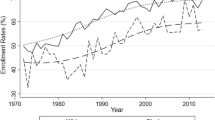Abstract
The relationship of various factors associated with college attendance and persistence for Hispanic women was investigated using the High School and Beyond data base. Socioeconomic background, educational aspirations, culture and language background, availability of financial aid, “cultural shock,” sex role socialization variables, and college preparation courses have all been identified in the literature as important factors influencing the college going and attendance patterns of Hispanic women. Using the 1982 First Follow-up data from the High School and Beyond Survey, the relative importance of these measures on college-going behavior was analyzed. Educational aspirations were found to be the most important predictor of college attendance and persistence. Sex role socialization was also found to be an important factor in explaining the college behavior patterns of Hispanic women. Women who delayed marriage and having a family were found to pursue a college career more often and tended to persist in college longer than those women who followed traditional sex role patterns. In addition, Hispanic women whose mothers had a college education were more likely to attend college themselves. Interestingly, participation in college preparation courses was found to rank much lower in importance than previously mentioned factors.
Similar content being viewed by others
References
Astin, A. W. (1977). Four critical years: Effects of college on beliefs, attitudes, and knowledge. San Francisco: Jossey-Bass.
Astin, A. W. (1975). Preventing students from dropping out. San Francisco: Jossey-Bass.
Brown, G. H., Rosen, N. L., Hill, S. T., & Olivas, M. A. (1980). The condition of education for Hispanic Americans. Washington, DC: National Center for Education Statistics.
Buriel, R. J., & Cardoza, D. (1988). The relationship of Spanish language background to academic achievement: A comparison of three generations of Mexican-American and Anglo-American high school seniors. In Garcia, J. R., Rodriguez, J. C. & Lomas, C. (Eds.), Times of Challenge: Chicanos and Chicanas in American Society (Mexican American Studies Monograph Series No. 6, pp. 69–81). Houston, Texas: University of Houston.
Cardoza, D., & Hirano-Nakanishi, M. J. (1984). Conceptualizing language factors in survey data: A look at the high school and beyond. Los Alamitos, CA: National Center for Billingual Research.
Chacon, M. A., Cohen, E. G., & Strover, S. (1986). Chicanas & Chicanos: Barriers to progress in higher education. In M. A. Olivas (Ed.), Latino College Students (pp. 296–324). New York: Teachers College Press.
Cope, R., & Hannah, W. (1975). Revolving college doors: The cause and consequences of dropping out and transferring. New York: John Wiley & Sons.
Dixon, R. (1975). Women's right and fertility. Studies in Planning, 17(1), 1–20.
Duncan, O. D., Haller, A. O., & Portes, A. (1968, September). Peer influences on aspiration: A reinterpretation. American Journal of Sociology, 119–137.
Duran, R. P. (1983). Hispanics' education and background: Predictors of college achievement. New York: College Board Publications.
Escobedo, T. H. (1980, October). Are Hispanic women in higher education the nonexistent minority? Educational Researcher, 9, 7–12.
Gandara, P. (1982). Passing through the eye of the needle: High-achieving Chicanas. Hispanic Journal of Behavioral Sciences, 4(2), 167–179.
Henderson, R. W., & Merrit, C. C. (1968). Environmental background of Mexican-American children with different potentials for schools success. The Journal of Psychology, 75, 101–106.
Munoz, D. G., & Garcia-Bahne, B. (1977). A study of the Chicano experience in higher education. The Center for Minority Group Mental Health Programs, Grant No. MN24597-01, National Institute of Mental Health.
National Center for Education Statistics. (1978). The educational disadvantage of language-minority persons in the United States. Washington, DC: National Center for Education Statistics.
National Opinion Research Center. (1980). High school and beyond: Language file codebook. Chicago: National Opinion Research Center.
Nielsen, F., & Fernandez, R. M. (1981). Achievement and Hispanic students in American high schools. Report to the National Center for Education Statistics under contract no. 300-78-0208. Chicago: National Opinion Research Center.
Padilla, A. M. (1980). The role of cultural awareness and ethnic loyalty in acculturation. In A. M. Padilla (Ed.), Acculturation: Theory, models and some new findings. American Association for the Advancement of Science (AAAS). Houston: Westview Press.
Pantages, T. J., & Creedon, C. F. (1978). Studies of college attrition: 1950–1975. Review of Educational Research, 48(1), 49–102.
Ramirez, M., III, & Casteneda, A. (1974). Cultural democracy, biocognitive development and education. New York: Academic Press.
Sanchez, A. A., & Cardoza, D. (1985). Aspects of educational success among low socioeconomic status Hispanic youth: A causal analysis using the High School and Beyond Survey. Los Alamitos, CA: National Center for Bilingual Research.
Sanchez, A. A., & Hernandez, A. A. C. (1985). The influence of significant others on the educational aspirations and achievement of foreign-born and U.S. born Hispanics (Report No. R-25). Los Alamitos, CA: The National Center for Bilingual Research.
Schwartz, A. J. (1971). A comparative study of values and achievement: Mexican-American and Anglo youth. Sociology of Education, 44, 438–462.
Sewell, W. H., Haller, A. O., & Ohlendorf, G. (1970, December). The educational and early occupational status attainment process: Replication and revision. American Sociological Review, 35, 1014–1027.
So, A. Y. (1984). The financing of college education by Hispanic parents. Urban Education, 19, 145–160.
So, A. Y., & Chan, K. S. (1982). What matters? A study of relative impact between SES and language background on educational achievement. Los Alamitos, CA: National Center for Bilingual Research.
Summerskill, J. (1974). Dropouts from college. In N. Sanford (Ed.), College and character: A briefer version of the American college. New York: John Wiley & Sons.
Szymanski, A. (1983). Class structure: A critical perspective. New York: Praeger.
Vasquez, M. J. T. (1982). Confronting barriers to the participation of Mexican-American women in higher education. Hispanic Journal of Behavioral Sciences, 4(2), 147–165.
Vincent, A., & Orum, L. S. (1984). Selected statistics on the education of Hispanics. Washington, DC: National Council of La Raza.
Author information
Authors and Affiliations
Rights and permissions
About this article
Cite this article
Cardoza, D. College attendance and persistence among hispanic women: An examination of some contributing factors. Sex Roles 24, 133–147 (1991). https://doi.org/10.1007/BF00288887
Issue Date:
DOI: https://doi.org/10.1007/BF00288887




